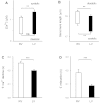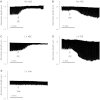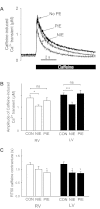Intraventricular and interventricular cellular heterogeneity of inotropic responses to α(1)-adrenergic stimulation
- PMID: 23355341
- PMCID: PMC3625891
- DOI: 10.1152/ajpheart.00822.2012
Intraventricular and interventricular cellular heterogeneity of inotropic responses to α(1)-adrenergic stimulation
Abstract
α1-Adrenergic receptors (α1-ARs) elicit a negative inotropic effect (NIE) in the mouse right ventricular (RV) myocardium but a positive inotropic effect (PIE) in the left ventricular (LV) myocardium. Effects on myofilament Ca(2+) sensitivity play a role, but effects on Ca(2+) handling could also contribute. We monitored the effects of α1-AR stimulation on contraction and Ca(2+) transients using single myocytes isolated from the RV or LV. Interestingly, for both the RV and LV, we found heterogeneous myocyte inotropic responses. α1-ARs mediated either a PIE or NIE, although RV myocytes had a greater proportion of cells manifesting a NIE (68%) compared with LV myocytes (36%). Stimulation of a single α1-AR subtype (α1A-ARs) with a subtype-selective agonist also elicited heterogeneous inotropic responses, suggesting that the heterogeneity arose from events downstream of the α1A-AR subtype. For RV and LV myocytes, an α1-AR-mediated PIE was associated with an increased Ca(2+) transient and a NIE was associated with a decreased Ca(2+) transient, suggesting a key role for Ca(2+) handling. For RV and LV myocytes, α1-AR-mediated decreases in the Ca(2+) transient were associated with increased Ca(2+) export from the cell and decreased Ca(2+) content of the sarcoplasmic reticulum. In contrast, for myocytes with α1-AR-induced increased Ca(2+) transients, sarcoplasmic reticulum Ca(2+) content was not increased, suggesting that other mechanisms contributed to the increased Ca(2+) transients. This study demonstrates the marked heterogeneity of LV and RV cellular inotropic responses to stimulation of α1-ARs and reveals a new aspect of biological heterogeneity among myocytes in the regulation of contraction.
Figures






References
-
- Cazorla O, Lacampagne A. Regional variation in myofilament length-dependent activation. Pflügers Arch 462: 15–28, 2011 - PubMed
-
- Cazorla O, Pascarel C, Garnier D, Le Guennec JY. Resting tension participates in the modulation of active tension in isolated guinea pig ventricular myocytes. J Mol Cell Cardiol 29: 1629–1637, 1997 - PubMed
-
- Davis JS, Hassanzadeh S, Winitsky S, Lin H, Satorius C, Vemuri R, Aletras AH, Wen H, Epstein ND. The overall pattern of cardiac contraction depends on a spatial gradient of myosin regulatory light chain phosphorylation. Cell 107: 631–641, 2001 - PubMed
Publication types
MeSH terms
Substances
Grants and funding
LinkOut - more resources
Full Text Sources
Other Literature Sources
Research Materials
Miscellaneous

